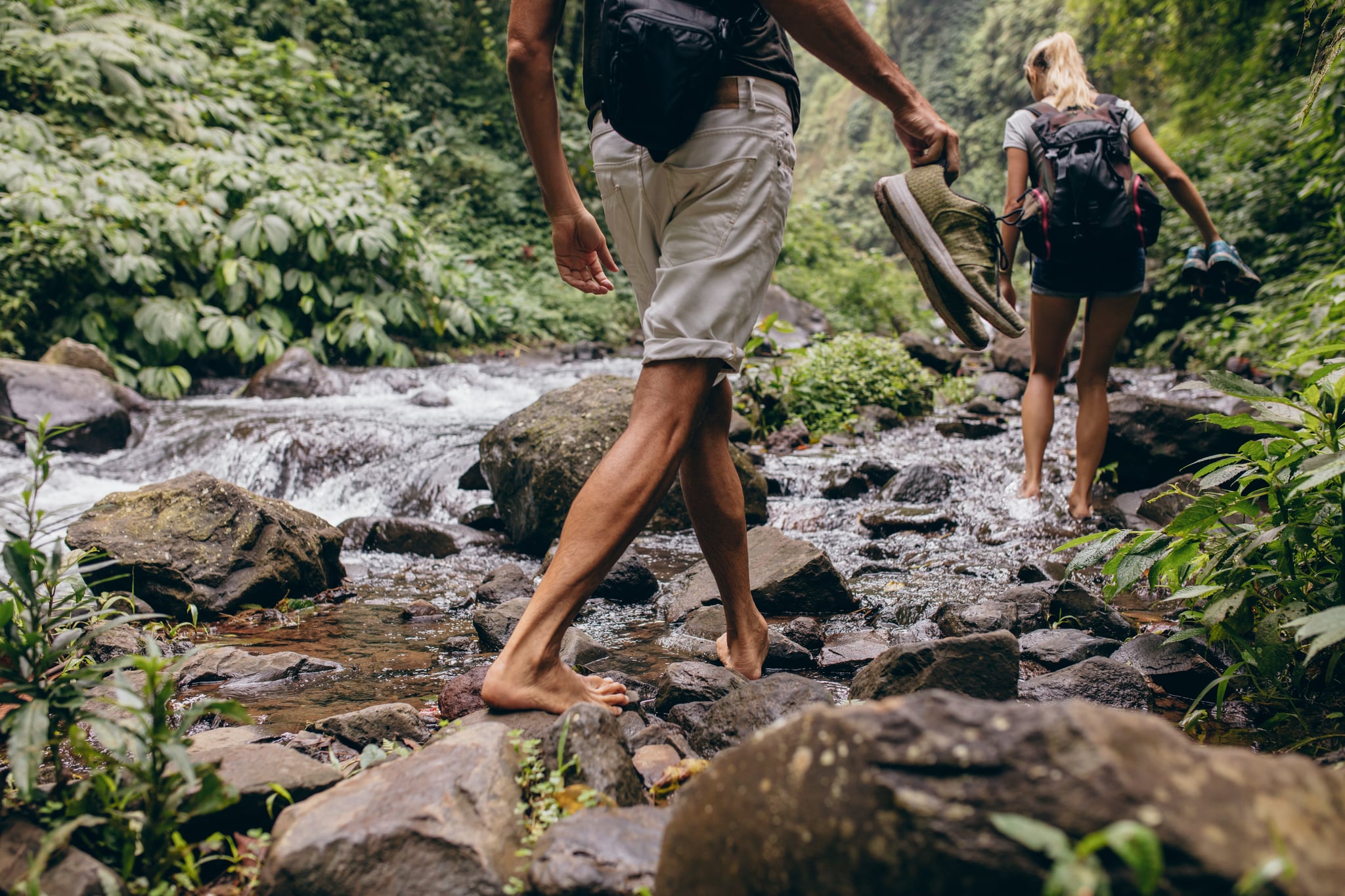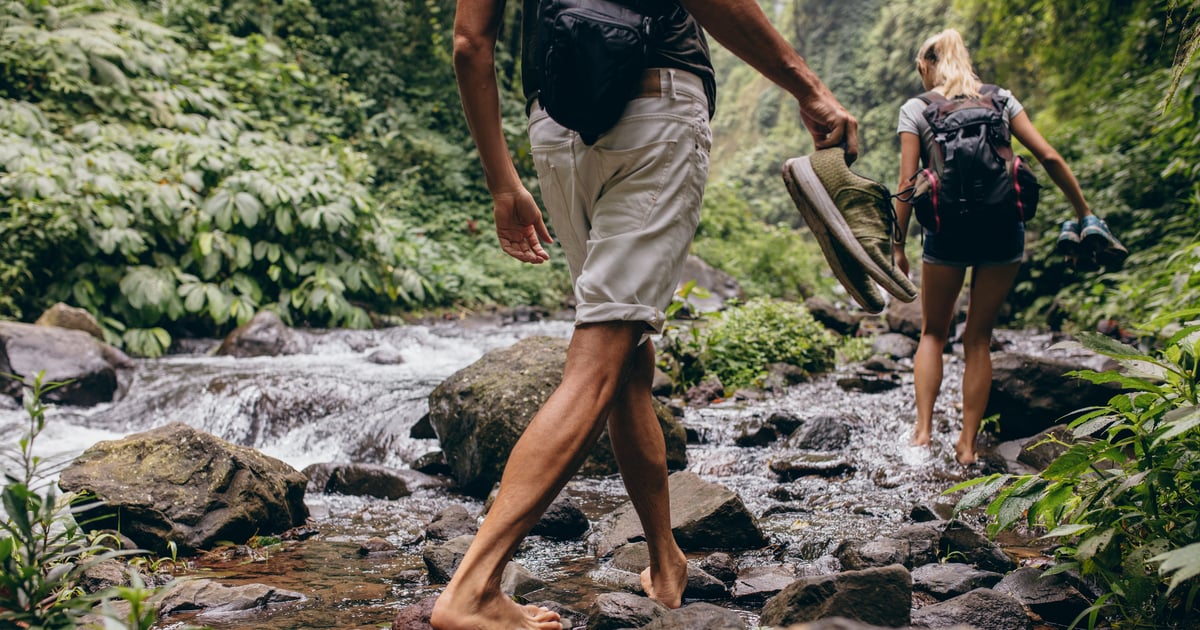Products You May Like

For most people, “No shirt, no shoes, no service” isn’t a suggestion. It’s a rule — with no workaround in sight. But for one Ohio couple, that rule no longer applies. In a now-viral video, TikTok user @ChristiFritz says she and her husband are so devoted to walking barefoot, they surgically removed the soles of all their shoes — a collection valued at $20,000, according to Fritz — so they can engage in the practice without detection in public establishments.
It’s hard to gauge tone on the internet, and some have suggested that the couple’s barefoot content is satirical or intended to incite outrage and rack up views. Their barefoot shoes video has been watched 55.9 million times since the account posted it at the end of January. But while most podiatrists wouldn’t recommend destroying footwear in order to engage in the practice, experts say there may be some benefits of barefoot walking.
What Is Barefoot Walking?
Barefoot walking goes by many names (see also: grounding and earthing), but the act is as self-explanatory as it sounds. Walking with exposed feet was the status quo until about 7,000 or 8,000 BCE, when the first known sandals were DIYed out of sagebrush bark. But even after shoes went mainstream, some cultures and individuals still prefer to walk or run without them.
Barefoot movement started creeping into the public consciousness in the 1960s and ’70s, thanks in part to acclaimed runners like India’s Shivnath Singh who competed barefoot. The practice became more widely practiced in 2005 when footwear brand Vibram released the Vibram FiveFinger, a minimalist toe shoe intended to mimic the effects of moving barefoot while still providing foot protection. The FiveFinger also enjoyed a surge in popularity thanks in part to fitness regimes like CrossFit that incorporate exercises, like rope climbs, that require a strong arch grip. “Athletes felt that the minimalist footwear was not only more natural, but made their feet and legs stronger. Some felt that they could grip the ground better for more stability during the workout,” says Jodi Schoenhaus, DPM, a podiatrist located in South Florida.
Now, thanks to that Ohio-based TikTok couple, barefoot walking is moving from outside the gym and onto the street again. But what are the potential benefits, exactly?
Benefits of Barefoot Walking
In her TikTok video, Fritz claims the benefits of barefoot walking are “priceless,” describing the practice as “freeing and detoxifying.” Podiatrists, on the other foot, prefer to look at the experience in more scientific terms.
- Barefoot walking may reduce inflammation and improve sleep: Walking barefoot helps ground the body, regulating the body’s electrical systems, says Suzanne Fuchs, DPM, a board-certified podiatrist and sports medicine specialist based in Palm Beach, FL. It can also stimulate nerve endings in the feet, enhance sensory input to the brain, and boost overall foot function — all of which can help improve sleep and reduce pain and inflammation. But Dr. Schoenhaus warns that what you see in the TikTok video isn’t barefoot walking as medicine intends it. Most of the research done on barefoot walking, or grounding, is analyzed based on participants walking on the natural earth (like minerals and grass). “The TikTok users are walking on concrete and man-made surfaces,” Dr. Fuchs says. “Natural surfaces like grass, sand, or dirt provide more varied terrain and require the feet to adapt to different textures, which can further enhance the benefits of barefoot walking.”
- Barefoot walking may improve balance: When performed on safe, clean surfaces, barefoot walking can strengthen foot muscles, improve sensory feedback, and promote a more natural foot movement pattern, reducing the risk of certain foot-related issues, per Dr. Fuchs.
- Barefoot walking may help develop muscles and strength: Parents might be interested to know that the American Podiatric Medical Association recommends that infants learning to walk skip shoes altogether while indoors in order to best encourage their developing musculature and strength. If you’ve ever wondered why baby feet are so squishable, it’s because humans are born with feet that contain only cartilage and no bones. Toddlers are especially encouraged to walk barefoot because some podiatrists believe that wearing shoes at young ages can inhibit a child’s cerebral growth and walking abilities.
Benefits aside, Dr. Fuchs advises potential barefoot walkers not to destroy your shoes. “Removing the soles of shoes can reduce stability and support, potentially increasing the risk of foot and ankle injuries,” Dr. Fuchs says. Instead, she recommends that people invest in minimalist shoes, designed to promote natural foot movement. These shoes, also known as barefoot shoes, are traditionally lightweight, have flexible soles, and offer less material support in the heel and less arch support.
Walking barefoot in your house is the safest option, while walking barefoot outdoors comes with a few potential risks. Potential injuries, sharp objects, and rough surfaces are top concerns, Dr. Fuchs warns. Walking shoeless in public spaces also raises the risk of contracting bacteria or infections.
As far as children are concerned, while there are benefits to going barefoot as an infant, children should not go barefoot long-term. A 2017 study analyzed how footwear affects young feet and determined that wearing shoes impacts how a child’s foot develops, suggesting that habitual shoe use might help the arch form. The American Podiatric Medical Association recommends that parents start transitioning their children into hard-soled shoes for outside wear after the child is able to walk independently, a milestone most children hit when they are between 10 and 18 months old.
How to Barefoot Walk Safely
Barefoot walking may not be a walk in the park for first-timers, so you’re going to want to ease into it. If you’re going to participate in barefoot walking, here’s a few tips to get you started:
- Opt for indoor spaces: Dr. Fuchs says indoor, private spaces are the safest for barefoot walking, citing social norms and hygiene concerns. Start here before kicking off your shoes.
- Try barefoot shoes: She also recommends barefoot shoes, like the FiveFinger, and then transitioning to barefoot walking to gradually allow your feet time to adapt to new movement patterns.
- Limit your time on your feet: When you’re ready to kick the shoes off, opt for short walking sessions (10 to 15 minutes) before going barefoot for longer.
Most notably, Dr. Fuchs suggests that people with foot conditions like diabetic foot ulcers, plantar fasciitis, bunions, or hammertoes should consult with a medical professional before engaging in habitual barefoot walking.
Ultimately, both experts agree that the safest kind of barefoot walking should be done indoors where your feet are safe from harm — and so are your sneakers. But if you want to take it outdoors, research suggests walking barefoot on grass, sand, or dirt (rather than man-made surfaces) is best.
